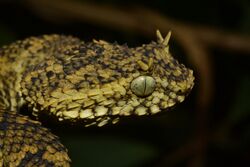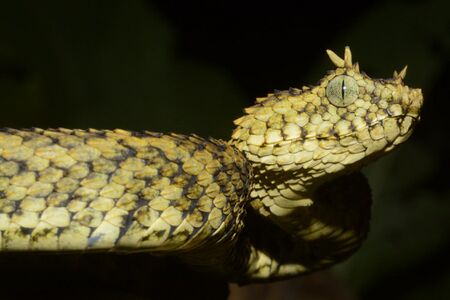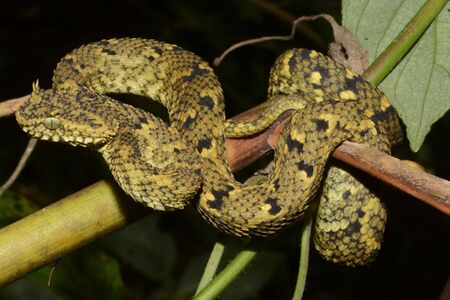Biology:Atheris ceratophora
| Atheris ceratophora | |
|---|---|

| |
| Scientific classification | |
| Domain: | Eukaryota |
| Kingdom: | Animalia |
| Phylum: | Chordata |
| Class: | Reptilia |
| Order: | Squamata |
| Suborder: | Serpentes |
| Family: | Viperidae |
| Genus: | Atheris |
| Species: | A. ceratophora
|
| Binomial name | |
| Atheris ceratophora F. Werner, 1895
| |

| |
| Synonyms[2] | |
| |
Atheris ceratophora is a venomous viper species endemic to a few mountain ranges in Tanzania. This used to be the only horned, arboreal viper known from Africa, until the discovery in 2011 of Atheris matildae, also found in Tanzania.[3] No subspecies are currently recognized.[6]
Description
It grows to a maximum total length (body + tail) of 54 cm (21 in). Females are slightly larger than males. The maximum total length for a male is reported to be 42 cm (17 in), the tail of which measured 8 cm (3.1 in).[7]
Easily recognized by a set of 3-5 horn-like superciliary scales above each eye. The rostral scale is more than twice as broad as high. There are 9 upper labials. The first 3 lower labials on each side are in contact with the one pair of chin shields.[7]
Midbody, the dorsal scales number 21-25. The ventral scale count is 142-152. There are 41-56 subcaudals.[7]
The color pattern consists of a yellowish-green, olive, gray or black ground color. This may or may not be overlaid by variable markings, sometimes in the form of irregular black spots or cross-bars that may be lined with yellow or white spots. The belly is dirty orange to almost black in color, sometimes with dark spots.[3]
Common names
Usambara bush viper,[3] horned bush viper,[4] eyelash bush viper,[5] Usambara mountain bush viper,[7] horned tree viper, Usambara tree viper.[8]
Geographic range
It is found in the Usambara and Uzungwe Mountains in Tanzania. It is probably also found in the Uluguru Mountains.[3]
The type locality is "Usambara" Mountains [Tanzania].[2]
Habitat
Found in grass and low bushes about 1 m (3.3 ft) above the ground[3] in woodlands and forests at altitudes of 700–2,000 m (2,300–6,600 ft).
Behavior
Like other Atheris species, it is probably active mainly at night, or at dawn or dusk.
Gallery
References
- ↑ Spawls, S.; Joger, U. (2019). "Atheris ceratophora". IUCN Red List of Threatened Species 2019: e.T178563A46182773. doi:10.2305/IUCN.UK.2019-2.RLTS.T178563A46182773.en. https://www.iucnredlist.org/species/178563/46182773. Retrieved 20 November 2021.
- ↑ 2.0 2.1 McDiarmid RW, Campbell JA, Touré T. 1999. Snake Species of the World: A Taxonomic and Geographic Reference, Volume 1. Washington, District of Columbia: Herpetologists' League. 511 pp. ISBN:1-893777-00-6 (series). ISBN:1-893777-01-4 (volume).
- ↑ 3.0 3.1 3.2 3.3 3.4 3.5 Spawls S, Branch B. 1995. The Dangerous Snakes of Africa. Ralph Curtis Books. Dubai: Oriental Press. 192 pp. ISBN:0-88359-029-8.
- ↑ 4.0 4.1 Atheris ceratophora at the Reptarium.cz Reptile Database. Accessed 2 August 2007.
- ↑ 5.0 5.1 Atheris ceratophora at The World Of Atheris. Accessed 8 September 2007.
- ↑ "Atheris ceratophora". Integrated Taxonomic Information System. https://www.itis.gov/servlet/SingleRpt/SingleRpt?search_topic=TSN&search_value=634942. Retrieved 13 July 2006.
- ↑ 7.0 7.1 7.2 7.3 Mallow D, Ludwig D, Nilson G. 2003. True Vipers: Natural History and Toxinology of Old World Vipers. Malabar, Florida: Krieger Publishing Company. ISBN:0-89464-877-2.
- ↑ Brown JH. 1973. Toxicology and Pharmacology of Venoms from Poisonous Snakes. Springfield, Illinois: Charles C. Thomas. 184 pp. LCCCN 73-229. ISBN:0-398-02808-7.
Further reading
- Boulenger GA. 1896. Catalogue of the Snakes in the British Museum (Natural History). Volume III., Containing the...Viperidæ. London: Trustees of the British Museum (Natural History). (Taylor and Francis, printers.) xiv + 727 pp. + Plates I.- XXV. (Atheris ceratophorus, p. 510.)
- Werner F. 1895. Ueber einige Reptilien aus Usambara (Deutsch-Ostafrika). Zoologisch-Botanische Gesellschaft in Wien 45: 190-194.
("Atheris ceratophora n. sp.", p. 194 + Plate V, Figures 1a-1e.)
External links
| Wikimedia Commons has media related to Atheris ceratophora. |
- Atheris ceratophora at Corallus.com. Accessed 8 October 2006.
- Atheris ceratophora at Baumpython.com. Accessed 8 October 2006.
Wikidata ☰ Q2699593 entry
 |






